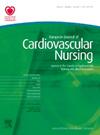首次急性心肌梗死中青年患者的社会心理适应变化及相关因素:一项纵向研究
IF 2.9
3区 医学
Q2 CARDIAC & CARDIOVASCULAR SYSTEMS
引用次数: 0
摘要
目的 本研究旨在探讨中青年首发急性心肌梗死(AMI)患者社会心理适应水平的变化趋势和群体异质性,并确定其影响因素。方法和结果 采用疾病社会心理适应量表分别评估患者出院后 1 个月、3 个月和 6 个月的社会心理适应水平。数据采用皮尔逊相关分析、广义估计方程和增长混合模型进行分析。共纳入了 233 名患者,他们在三个时间点的社会心理适应评分分别为(57.18±15.50)分、(36.17±15.02)分和(24.22±12.98)分。患者社会心理适应水平的变化轨迹被分为三个潜在类别:中度适应改善组(72.5%)、低度适应改善组(16.3%)和持续适应不良组(11.2%)。其中,持续适应不良组的预测因素包括无配偶、家庭人均月收入低、体重指数正常、从不吸烟、从不运动、合并高脂血症、社会支持低、屈从应对和高感知压力。结论 首次发病的中青年 AMI 患者的社会心理适应水平在出院后 6 个月内呈上升趋势,社会心理适应水平的变化轨迹存在群体异质性。建议今后开展多中心、大样本的纵向研究,延长随访调查时间,进一步明确不同亚型患者社会心理适应的变化轨迹和影响因素,为制定有针对性的干预方案提供理论依据。本文章由计算机程序翻译,如有差异,请以英文原文为准。
Psychosocial adjustment changes and related factors in young and middle-aged patients with first-episode acute myocardial infarction: a longitudinal study
Aims This study aimed to explore the change trend and group heterogeneity of psychosocial adjustment level and to determine its influencing factors among young and middle-aged patients with first-episode acute myocardial infarction (AMI). Methods and results The Psychosocial Adjustment Scale of Illness was used to assess the psychosocial adjustment level of the patients at 1, 3, and 6 months after discharge, respectively. Data were analyzed using Pearson correlation analysis, generalized estimating equations, and growth mixed models. A total of 233 patients were included, and their psychosocial adjustment scores at the three-time points were 57.18 ± 15.50, 36.17 ± 15.02, and 24.22 ± 12.98, respectively. The trajectories of changes in patients’ psychosocial adjustment levels were divided into three latent categories: moderate adjustment improvement group (72.5%), low adjustment improvement group (16.3%), and persistent maladjustment group (11.2%). Among them, predictors of the persistent maladjustment group included no spouse, low monthly family income per capita, normal body mass index, never smoking, never exercising, combined with hyperlipidemia, low social support, submission coping, and high perceived stress. Conclusions The psychosocial adjustment level of young and middle-aged patients with first-episode AMI showed an upward trend within 6 months after discharge, and there was group heterogeneity in the change trajectory of psychosocial adjustment level. It is suggested that a multi-center, large-sample longitudinal study should be carried out in the future, and the time of follow-up investigation should be extended to further clarify the change trajectory and influencing factors of psychosocial adjustment of patients with different subtypes, to provide the theoretical basis for formulating targeted intervention programs.
求助全文
通过发布文献求助,成功后即可免费获取论文全文。
去求助
来源期刊

European Journal of Cardiovascular Nursing
CARDIAC & CARDIOVASCULAR SYSTEMS-NURSING
CiteScore
5.10
自引率
10.30%
发文量
247
审稿时长
6-12 weeks
期刊介绍:
The peer-reviewed journal of the European Society of Cardiology’s Council on Cardiovascular Nursing and Allied Professions (CCNAP) covering the broad field of cardiovascular nursing including chronic and acute care, cardiac rehabilitation, primary and secondary prevention, heart failure, acute coronary syndromes, interventional cardiology, cardiac care, and vascular nursing.
 求助内容:
求助内容: 应助结果提醒方式:
应助结果提醒方式:


